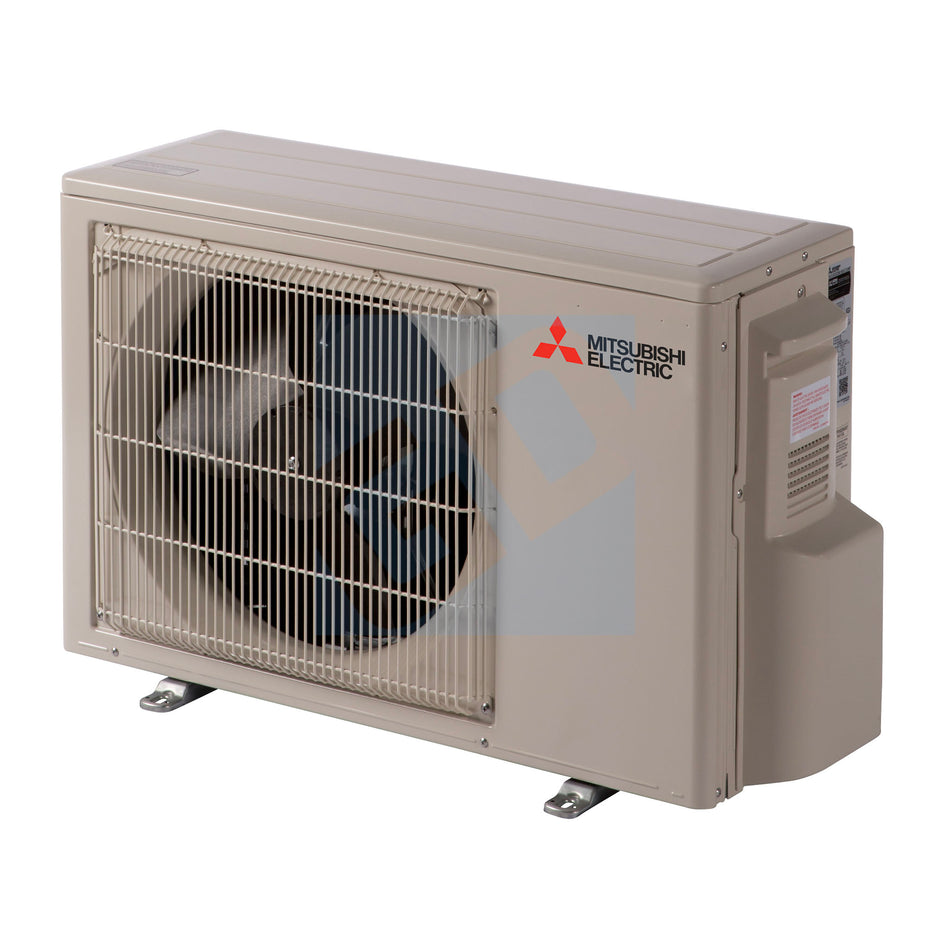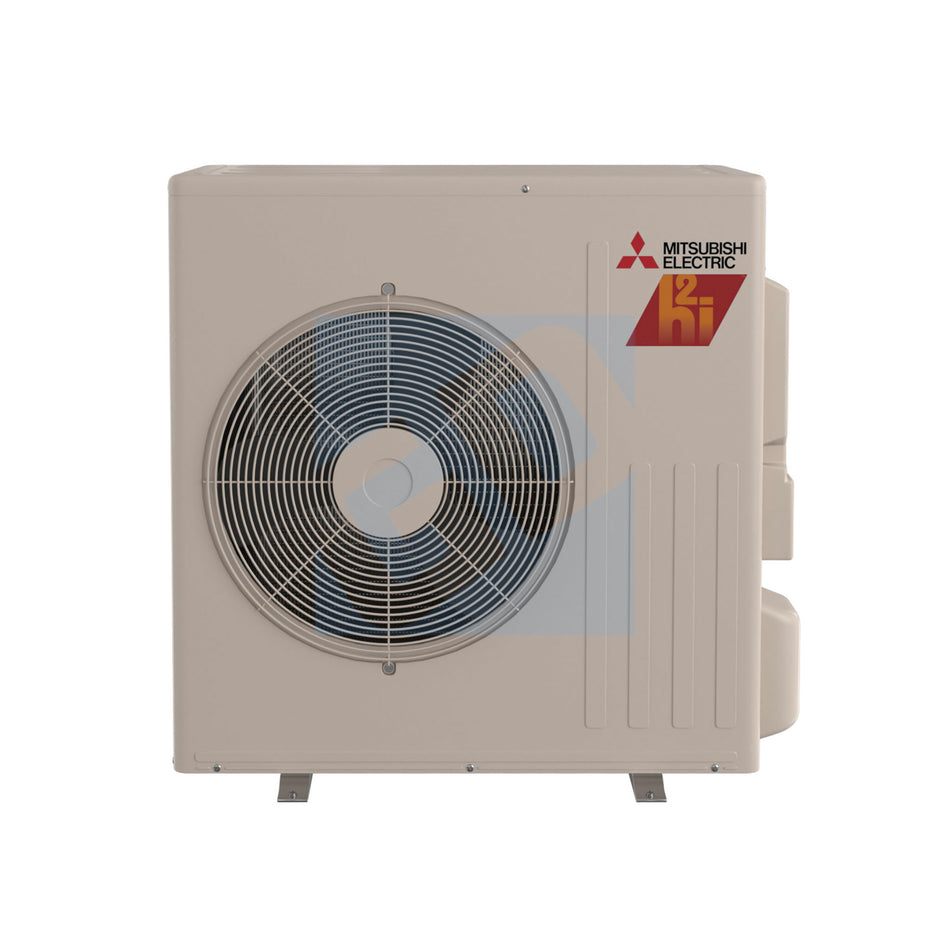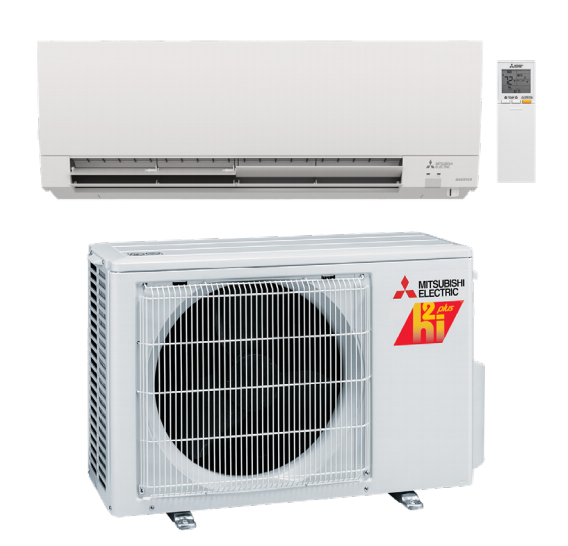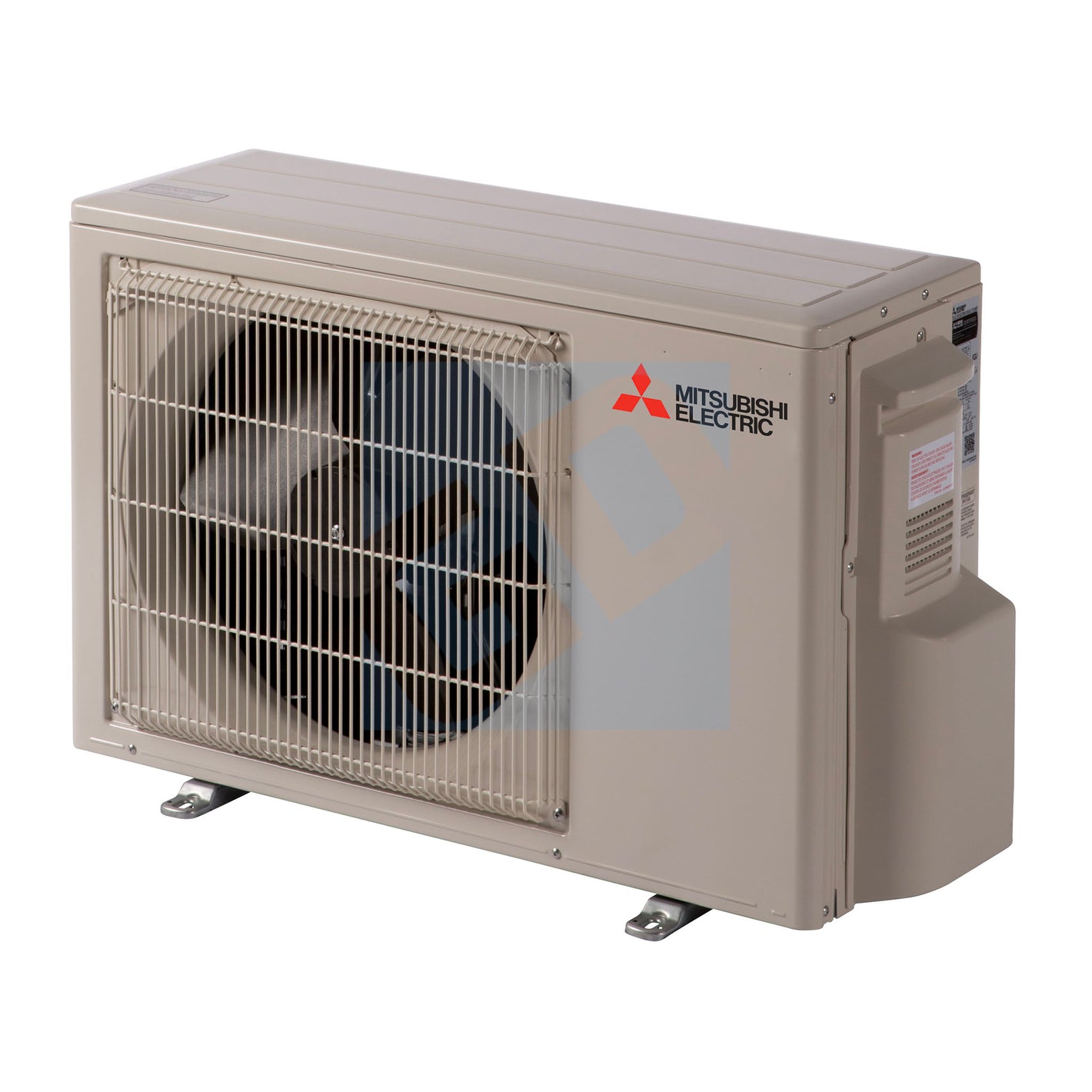Since ductless air conditioners were introduced into the US, they’ve grown in popularity. For good reason, they’re extremely efficient & almost noiseless. And depending on your situation, they can replace central heating & cooling systems in almost every way.
We’ll go into detail about ductless air conditioners and how they compare to central systems. Once you’re finished reading our article, you’ll know which one’s better for your specific situation.
Ductless Heating & Air Conditioning vs. Central Heating & Air Conditioning
First, let’s run through what a ductless mini-split system is.
Ductless systems have one outdoor unit (the condenser) and at least one indoor unit (the evaporator) inside of your home. Both the indoor and outdoor units are connected with copper-insulated refrigerant lines that pump cooled or heated refrigerant directly between the indoor and outdoor units.

Comparisons of Both Types of Systems
|
Central Systems |
Ductless Systems |
|
|
⭐⭐⭐☆☆ |
⭐⭐⭐⭐☆ |
|
|
⭐⭐⭐⭐☆ |
⭐⭐☆☆☆ |
|
|
⭐⭐☆☆☆ |
⭐⭐⭐⭐☆ |
|
|
⭐⭐⭐☆☆ |
⭐⭐⭐⭐☆ |
|
|
⭐⭐⭐⭐☆ |
⭐⭐⭐⭐⭐ |
|
|
⭐⭐⭐☆☆ |
⭐⭐⭐⭐⭐ |
|
|
⭐⭐⭐☆☆ |
⭐⭐⭐⭐☆ |
Now, let’s go through each category individually.
“From Scratch” Cost
Our “from scratch” cost is the cost of each system if you’re planning on constructing a new building.
Depending on which contractor you talk to, this rating can swing either way.
Large buildings like churches, office buildings, and schools are going to need multiple systems. It doesn't matter if you decide to move ahead with ductless or central HVAC systems. Most larger buildings have multiple HVAC systems regulating different parts of the building.
Smaller residential buildings and houses will typically need one outdoor unit and either ductwork installed (central systems) or indoor evaporators (ductless systems).
Ductwork alone can cost high hundreds to multiple thousands depending on how large the building is. Plus ductwork adds to overall construction costs and takes room away from your building. Again, ductless systems don’t need ductwork and can heat or cool fairly large rooms.
Replacement Cost
There’s a big difference between replacing an existing central HVAC system versus a ductless system.
The majority of the time, only the air conditioner/furnace/heat pump needs to be replaced on a central heating and cooling system. In HVAC industry lingo, it’s called a change-out. But keep in mind that ductwork will need to be replaced eventually because it does wear.
On the other hand, your contractor will need to diagnose which part of your ductless system needs repair/replacing. Each zone (or room) has a separate evaporator connected to one or more outdoor condensers. If only one indoor unit is acting up, it’s pretty easy to diagnose the issue.
As far as replacement costs comparatively, the more indoor units that need replacing on your ductless system, the more expensive your replacement costs will be. A ducted “change-out” usually only has one cost - the system itself.
Operating Cost
This can depend. 98% of the time a whole home mini-split system will be less expensive to operate than a conventional system.
Besides being more energy-efficient, the reason ductless systems have lower operating costs over central air systems is they operate independently. Each mini-split has a thermostat that regulates its own specific unit, turning it on and off.
Also, all mini-splits have variable-speed inverters that ramp up and down depending on how much heating/cooling a room needs. In comparison, the majority of central air systems sold today are single stage. The difference between the two being ductless units only use as much energy that’s needed, central units are either totally on or off.
Central air conditioners and heat pumps can have inverters just like ductless units. They can also have higher SEER ratings - but most don’t.
Construction Time
Any construction you’re having done to your home or building is a little inconvenient. But there’s a big difference in how both types of HVAC systems are installed.
The main differentiator is ductwork. Central air systems use ductwork to move conditioned air around a building. Installing ducts if they’re needed is labor-intensive and can take a long time. A simple change-out (without duct-work) shouldn’t take more than two days though.

Most ductless single-zone systems can be installed in a half day. Multi-zones will take a bit longer. But you shouldn’t be looking at more than a week for a residential project. Commercial projects usually take a bit longer because more systems are being installed.
For a central air system “change-out,” there’s very little time or mess involved. The same for a ductless system. But whenever ductworks involved, you’re looking at a lot longer construction time and potentially a lot more mess.
Zoning Capabilities
Zoning your air conditioning system is when you create customized temperature “zones” through your home. In zoned ducted and ductless systems, you’re able to control each zoned area independently. You get three main benefits from zoning: you save energy, improve your indoor air quality, and extend the life of your system.
Central air systems that are zoned use multiple thermostats and special dampers in the ductwork to direct and redirect airflow. When a zone reaches the temperature it was programmed, the dampers close. That specific zone doesn’t receive any more heat or ac. Commonly with forced air systems, your home is zoned by floor.
Ductless heat pumps have the unique advantage of being automatically zoned. Each indoor evaporator controls the environment of the room it’s in. The evaporators have thermostats which keep each room at the temperature you set.
Ductless systems offer a much higher level of built-in zoning over central air systems. The top-level of your home won’t be a completely different temperature than your basement - unless you want it to be.
Efficiency
When you’re considering any heating or cooling source, efficiency plays a big role. The more energy efficient a system is, the less it will cost to operate compared to other systems.
It’s common for central air systems to lose 30% of the energy they use through the ductwork. Their energy loss is because of air leaks and conduction (the ductwork absorbing the heat).
Ductless systems are efficient because there are no air leaks or conduction, and they use inverters. Inverters let mini-splits operate at different speeds. Like a gas pedal, an inverter allows the mini-split to give each room the right amount of power of heating/cooling it needs.
Quality of Indoor Air
Both central air systems and mini-splits can clean and improve the air quality of your home.
The vast majority of central air systems aren’t equipped to clean and purify your air. The standard paper filters are only meant to protect your system from dust and debris. Even HEPA filters don’t remove VOCs, pathogens, and microorganisms. To remove air pollutants, you’ll need an air purification system.
Ductless systems have built-in, washable air filters. The filters in mini-splits are meant to last years, capture and remove contaminants. And Mitsubishi took air filtration a step further with their Platinum Deodorizing filters.
Whole-home air purifiers work well if they’re set up properly by your HVAC contractor. But they require a decent amount of maintenance. The unfortunate part of central air purification systems is they require constant air circulation to do their job properly. Meaning your system is constantly running and using energy.
A good alternative would be a portable air purification system like the Enviro Klenz.
Most Common Factors When Deciding On Ductless
The biggest influencing factor that most people use to decide for or against installing a ductless system is cost. If your house has existing ductwork, a central system would be less expensive than a full-home ductless system. If you’re contemplating putting in ductwork, a ductless system is more than likely the way you should go.
Cost is the biggest factor, but looks are a big factor as well. The ceiling & ducted mini-splits can be hidden, but the wall & floor units hang from the wall. Most people say after a couple of days you'll stop noticing the wall & floor units, but they’re not concealed like ducts are.
To allow the ductless units to blend in with your other decor, LG came out with a picture frame. We also offer system wrapping if you want it. We have a feeling as ductless mini-splits become even more popular, manufacturers will come out with sleeker designs.
Converting from your current heat source or your need for supplemental heat/ac is going to play a big part as well. We’ve had people come in to put ductless units in their home. Electricity (what ductless systems use to heat/cool your home) was a lot less expensive than the oil they were buying. And after one year, they made the cost of installing the systems back in savings.
The Different Types of Situations For Ductless
Over the years, we’ve installed ductless systems in almost every application. Both residential and commercial buildings have plenty of reasons why a mini-split would the preferred installed system. We’ll go over a few now.
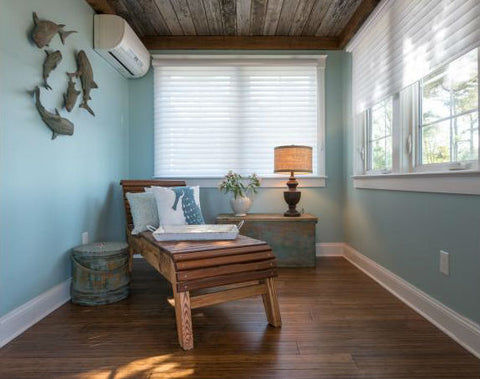
Existing Houses & Construction
Have you been in a room that was always hotter/colder than the rest of the house? Most of the times, it’s the basement or upstairs bedroom. For some reason, it’s always 10 degrees hotter upstairs and 10 degrees colder downstairs than the rest of the house.
That’s because most central HVAC systems have one thermostat to communicate with. The HVAC system reads the thermostat (which is usually out of the way) and turns on/off depending on the temperature it reads. It’s not the best way to keep you comfortable. That’s the reason Ecobee created their wi-fi enabled thermostat & sensors, to gauge your whole home and signal your thermostat to automatically adjust the temperature for better comfort & energy savings.
New Houses & Construction
When designing a building from the ground up, one of the greenest HVAC options is ductless. Mini-splits run totally on electricity, which in the US is fairly cheap. And if you’re thinking about installing solar as well, it’ll be your greenest energy source.
You’ll get the added benefit of lower energy bills because each system operates independently. Zoning allows room to be cooled while the others aren’t working. It’s like zoning for your car, the driver can have a set temperature and passengers can have their own.
Additions to Houses & Building
Most times ductless units are ideal for additions. You can install a single system and you don’t have to worry about adding onto your existing HVAC unit.
You don’t need to upgrade your system because it can’t handle the additional capacity, which is somewhat common. And usually, when you install additional ductwork, your system needs to be rebalanced.
Having a ductless system cuts all the additional costs of upgrading, additional ductwork and rebalancing out.
Most Common Types of Rooms/Applications
We’re not just an online & retail store - we’re also certified installer of ductless systems. That gives us insight (from experience) of what types of rooms people and companies are installing ductless systems into.
We’ll break the rooms & applications down between residential and commercial. Hopefully, that gives you a better idea of what to expect for your situation.
Residential
The most common rooms people choose ductless overextending their central air systems into are offices, nurseries, basements, and sunrooms.
We’ve also seen:
- Barns
- Master Bedrooms
- Living Rooms
- Dining Rooms
- Entire Guest Houses
We’ve seen and/or installed a ductless system into most rooms in someone’s house. Lots of times, it depends on the current source of your heat. Natural gas, propane, and oil are great because electricity is usually less expensive than all three.
But there are some situations where you wouldn’t want to install a mini-split heat pump. An example would be if the only addition you’d need to make to your current system would be to run ducts. Maybe you're adding a room onto your house and your current HVAC system already can heat/cool that room. Running ducts would be the ideal solution.
Most of the time when we install a ductless system, we see your current gas furnace, heat pump or HVAC system is currently at capacity. Adding ducts in that situation would burden the entire HVAC system. Which makes ductless heating and cooling a perfect solution for you.
Commercial
There are plenty of commercial applications where ductless systems are useful. Everything from hotels to office buildings uses ductless units to provide personal comfort. Some of the most common buildings that use mini-splits are:
- Churches
- Hotel Rooms
- Community Centers
- Restaurants
- Multi-family buildings
- Apartments
- Schools
It takes a lot of energy to cool or heat larger commercial areas, and that’s where ductless systems shine. Even buildings with large spaces like church sanctuaries can use ductless units.
Also, zoning is a big benefit for commercial buildings. Take community centers for example. There are lots of instances where only part of the building is being used. You’re able to heat/cool specific rooms without turning on the whole central HVAC system - saving you energy.
What’s the Final Verdict: Ductless or Ducted?
If you're building a home from the ground up, you should look for active quotes on both central and ductless systems. Depending on the size of your house, the quotes should be around the same cost.
If you're adding one or two rooms onto your home and want them heated/cooled year-round, ductless will be perfect for you. You can check our pricing, be the pro-install price on all of our systems is probably close to what you're going to get quoted in your area.
Comparing ductless and central air, if you're adding two rooms you're looking at 6k - 7k including all the accessories and installation. Getting a quote on the central ac system is your best bet. If you have to upgrade your system and install ducts you're looking at 6k - 10k or more.
There are lots of instances where ductless systems have an advantage over central ducted systems. Among other reasons, the energy savings, zoning, quick installation, and active filtration are what people enjoy about ductless systems. Feel free to reach out to one of our designers to talk through if ductless is a good option for your situation.



